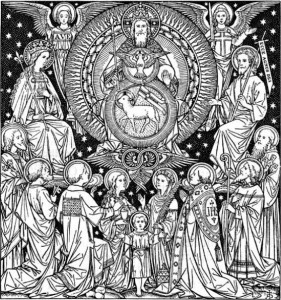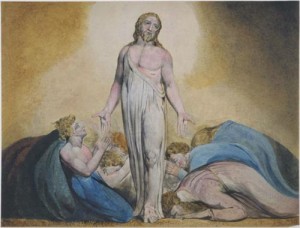====================
This sermon was preached on the Feast of the Holy Trinity, May 26, 2013, at St. Paul’s Episcopal Church, Medina, Ohio, where Fr. Funston is rector.
(Revised Common Lectionary, Trinity (Year C): Proverbs 8:1-4,22-31; Canticle 13 (Song of the Three Young Men, 29-34); Romans 5:1-5; and John 16:12-15. These lessons can be read at The Lectionary Page.)
====================
![]() I’d like you to take out a pen (there are some in the pew racks if you don’t have one of your own) and on a blank piece of paper, or an empty spot on your service bulletin, I’d like you write down these numbers:
I’d like you to take out a pen (there are some in the pew racks if you don’t have one of your own) and on a blank piece of paper, or an empty spot on your service bulletin, I’d like you write down these numbers:
1,016,823
116,516
405,399
36,516
58,209
2,031
4,487
22
3
They are, respectively:
1,016,823 – the estimated number of war dead from the American civil war (the figures, especially for Confederate dead, are notoriously untrustworthy)
116,516 – the number of Americans who died in World War I
405,399 – the number of Americans who died in World War II
36,516 – the number of Americans who died in the Korean conflict
58,209 – the number of Americans who died in Vietnam
2,031 – the number of Americans who so far have died in Afghanistan during our so-called “war on terror”
4,487 – the number of Americans who so far have died in Iraq during our so-called “war on terror”
22 – the average number of U.S. Armed Forces veterans and active duty personnel who commit suicide every day because of combat-related PTSD
3 – the number of Persons in the One, Holy, Blessed, and Glorious Trinity
Today, our church asks us to focus our attention on the last of these numbers. Tomorrow, our country asks us to remember all the others. It is merely fortuitous that the calendar, this year, conflates the Feast of the Blessed Trinity with Memorial Day weekend, but it seems to me that the two speak to us with a united voice drawing our attention to common themes.
Memorial Day has its origins in a proclamation by General John A. Logan, commander-in-chief of the Grand Army of the Republic, the organization for Union Civil War veterans. On May 5, 1868, he called for an annual, national “Decoration Day.” It was observed for the first time that year on May 30; the date was chosen because it was not the anniversary of any particular battle and because it was the optimal date for flowers to be in bloom in most areas of the country. It was observed, that first year, in 27 states. A similar day of remembrance was held in the states of the former Confederacy on June 3, which was the birthday of Jefferson Davis, first and only President of the Confederate States of America. Beginning in the 1880s the name “Memorial Day” began to be used for these commemorations and it gradually became the more common term. For the first hundred years, these holidays were matters of state law, although in 1950 Congress issued a joint resolution requesting the President to issue a proclamation calling for a national observance on May 30 and every year since the presidents have done so. In 1967, by act of Congress, “Memorial Day” was declared the official name and May 30 the official date under Federal law. The following year, Congress passed the Uniform Monday Holiday Act, which moved Memorial Day, together with Washington’s birthday, Labor Day, Columbus Day, and Veterans Day, from their traditional dates to specified Mondays in order to create convenient three-day weekends.
The Veterans of Foreign Wars, by the way, opposed that change and has publicly stated its position that, “Changing the date merely to create three-day weekends has undermined the very meaning of the day.” Throughout his career in the Senate, the late Senator from Hawaii Daniel Inouye, a World War II veteran, annually introduced a measure to return Memorial Day to its traditional date of May 30. Obviously, his efforts proved unsuccessful.
The Solemnity, or Principal Feast, of the Most Holy Trinity has a somewhat longer history. The Sacramentary of St. Gregory the Great (who was pope from 590 to 604) contained prayers and a Preface for a celebration of the Trinity, but specified no date. Documents from the pontificate of Gregory VII (pope from 1073 to 1085) indicate that by that time an Office of the Holy Trinity was recited on the Sunday after Pentecost in some places, but it was not a universal practice. In 1162, Thomas á Becket (1118–70) was consecrated Archbishop of Canterbury on the Sunday after Pentecost, and his first act was to proclaim that the day of his consecration should be commemorated as a new festival in honor of the Holy Trinity. This observance spread from England throughout the western Catholic world until Pope John XXII in 1334, the last year of his 18-year papacy, ordered the feast observed by the entire Church on the first Sunday after Pentecost.
I want to suggest to you today that these two observances, one secular and one religious, share two common themes, and that this year’s fortuitous coincidence of Trinity Sunday and Memorial Day weekend allows us to explore them. Those themes are community and mystery.
There is a humorous video on YouTube made by a group calling themselves Lutheran Satire in which two Irishman engage St. Patrick in a dialog about analogies for the Holy Trinity. Although at first pronouncing themselves simple and unsophisticated, the two proceed to demonstrate considerable theological acumen as they condemn Patrick as a heretic each time he tries an analogy. The famous water-ice-steam analogy, they condemn as Modalism; the analogy of the sun, with its light and heat, they denounce as Arianism; when Patrick tries to liken the Trinity to a shamrock, they stop him and criticize him for preaching Partialism. Finally, Patrick gives up and asserts:
The Trinity is a mystery which cannot be comprehended by human reason, but is understood only through faith and is best confessed in the words of the Athanasian Creed which states that we worship one God in Trinity, and Trinity in Unity, neither confusing the Persons nor dividing the Substance, that we are compelled by the Christian truth to confess that each distinct Person is God and Lord, and that the deity of the Father, the Son and the Holy Spirit is One, equal in glory, co-equal in majesty.
The two Irishman, after a moment of stunned silence, respond, “Well, why didn’t you just say that?”
So there you have it: the Trinity is a mystery and every analogy by which we try to explain how God can be one-in-three fails, every attempt to comprehend the unity in which the Father, the Son, and the Holy Spirit together are one God ends up in heresy, and every sermon about the Doctrine of the Trinity either confuses the heck out of us or bores us to tears.
Therefore, rather than try to explain or comprehend the mystery that is the Trinity, let’s focus instead on the community that is the Trinity: the paradigm and model of all human community. The early Church Fathers explored in their writings how many aspects of our humanity reveal the divine image: our ability to perceive God’s presence; our apparently innate knowledge of the spiritual realm; our intellect; our ability to freely choose; and our capacity to live lives of goodness and love. These characteristics, they taught, belong to every human being and reveal much about God.
In the twentieth-century theologians have explored the concept of human personhood. To be made in the image of God is not to be made in the image of the Father only; it is to be made in the image of the Holy Trinity, to be made in the image of the Father, and of the Son, and of the Holy Spirit. Human beings are persons intended to be, like the Persons of the Blessed Trinity, in relationship with other persons. This means that participation in community is at the heart of our humanity; our relatedness to other persons is at the very core of who we are. The three Divine Persons are forever united with each other in mutual love. They dwell within one another; they collaborate and share in all their activities; they always act in harmonious accord. This is the model for the ideal human community, the paradigm of corporate human existence.
Human beings are supposed to work together in harmony in ways that preserve and respect the equality and dignity of every person. The English Orthodox bishop and theologian Kallistos Ware put it this way in an article in the journal of the Fellowship of St Alban & St Sergius:
Each social grouping — family, parish, diocese, church council, school, office, factory, nation — has as its vocation to be transformed by grace into a living icon of [the Holy Trinity], to effect a reconciling harmony between diversity and unity, human freedom and mutual solidarity, after the pattern of the Trinity. (The Human Person as an Icon of the Trinity, Sobornost 8, 17-18)
He also wrote in a later essay:
Belief in a God who is three-in-one, whose characteristics are sharing and solidarity, has direct and practical consequences for our Christian attitude toward politics, economics, and social action, and it is our task to work out these consequences in full detail. Each form of community — the family, the school, the workplace, the local eucharistic center, the monastery, the city, the nation — has as its vocation to become, each according to its own modality, a living icon of the Holy Trinity. (The Trinity: Heart of Our Life, in Reclaiming the Great Tradition: Evangelicals, Catholics and Orthodox in Dialogue, James S. Cutsinger, ed., InterVarsity:1997, 142)
On Friday, as has been customary in this country since 1950, the president issued a proclamation designating Memorial Day tomorrow as “a day of prayer for permanent peace.” In his proclamation, President Obama said:
On Memorial Day, we remember those we have lost not only for what they fought for, but who they were: proud Americans, often far too young, guided by deep and abiding love for their families, for each other, and for this country. Our debt to them is one we can never fully repay. But we can honor their sacrifice and strive to be a Nation equal to their example. On this and every day, we must meet our obligations to families of the fallen; we must uphold our sacred trust with our veterans, our service members, and their loved ones.
Above all, we can honor those we have lost by living up to the ideals they died defending. It is our charge to preserve liberty, to advance justice, and to sow the seeds of peace. With courage and devotion worthy of the heroes we remember today, let us rededicate ourselves to those unending tasks, and prove once more that America’s best days are still ahead. Let us pray the souls of those who died in war rest in eternal peace, and let us keep them and their families close in our hearts, now and forever. (Presidential Proclamation, May 24, 2013)
In other words, Memorial Day, like Trinity Sunday, is a day whose theme is community, the nation as community, the military services as community, the family as community. Bishop Ware’s description of Trinitarian community as embracing “diversity and unity, human freedom and mutual solidarity” could as easily have been used by the president to describe the community which celebrates Memorial Day; President Obama’s words of courage and devotion, sacrifice and trust, justice and eternal peace could as easily have been used to describe the community which is an icon of the Trinity.
There is also a mystery about Memorial Day, and the mystery is this: Why must young men and now young women go to war and die? One of my favorite Celtic folk songs reflects on this mystery. It was written in 1976 by the Scottish folksinger Eric Bogle and originally entitled No Man’s Land, but it is more commonly called The Green Fields of France or Willie McBride. It is the musing of a man stopping by a grave in a World War I cemetery and wondering about the man buried there. These are the last two verses:
Ah the sun now it shines on these green fields of France,
The warm summer breeze makes the red poppies dance,
And look how the sun shines from under the clouds;
There’s no gas, no barbed wire, there’re no guns firing now.
But here in this graveyard it’s still No Man’s Land,
The countless white crosses in mute witness stand
To man’s blind indifference to his fellow man,
To a whole generation that was butchered and damned.Ah, young Willie McBride, I can’t help wonder why,
Did all those who lay here really know why they died?
And did they believe when they answered the call,
Did they really believe that this war would end war?
For the sorrow, the suffering, the glory, the pain,
The killing and dying were all done in vain,
For, young Willie McBride, it all happened again,
And again and again and again and again.
The mystery of Memorial Day is the mystery of war. No one wants it to happen, and yet it does, again, and again, and again, and again . . . The mystery of Memorial Day is . . . why?
The mystery of the Trinity is expressed in that number 3: How can God who is One be Three? It’s a mystery which we cannot comprehend. It can be understood only through faith; it can be lived out only in community.
The mystery of Memorial Day is expressed in those other numbers: 1,016,823 — 116,516 — 405,399 — 36,516 — 58,209 — 2,031 — 4,487 — 22. It’s a mystery we must comprehend and, through our faith and in our communities, bring to an end. Please take home the paper on which you wrote those numbers and tomorrow . . . think about that.
Let us pray:
Almighty God our heavenly Father, guide the peoples and nations of the world into the way of justice and truth, and establish among them that peace which is the fruit of righteousness, that the community of humankind may become more and more an image of the community of the Holy Trinity; through our Lord and Savior Jesus Christ. Amen.
====================
A request to my readers: I’m trying to build the readership of this blog and I’d very much appreciate your help in doing so. If you find something here that is of value, please share it with others. If you are on Facebook, “like” the posts on your page so others can see them. If you are following me on Twitter, please “retweet” the notices of these meditations. If you have a blog of your own, please include mine in your links (a favor I will gladly reciprocate). Many thanks!
====================
Father Funston is the rector of St. Paul’s Episcopal Church, Medina, Ohio.
 A few days ago an ordained colleague posted this status to Facebook:
A few days ago an ordained colleague posted this status to Facebook: I was told once that there is a difference between Yankee fairy tales and Northern fairy tales, and the difference is found in the way they begin. Yankee fairy tales start off, “Once upon a time . . . . ” Southern fairy tales begin, “Y’all ain’t gonna believe this!”
I was told once that there is a difference between Yankee fairy tales and Northern fairy tales, and the difference is found in the way they begin. Yankee fairy tales start off, “Once upon a time . . . . ” Southern fairy tales begin, “Y’all ain’t gonna believe this!” Which brings us to the second story, the “y’all ain’t gonna believe this” story of the first Christian Pentecost. The twelve (with the addition of Matthias a few days before) who would become known as the Apostles were again together in the Upper Room, perhaps together with several other disciples including all those women, Joanna, Suzanna, Mary the mother of James, Mary Magdalen, and the other Mary, those women who “used to follow him and provided for him when he was in Galilee.” (Mark 15:41) The first ECW! They were there in that room where they’d shared that last supper, that Passover meal with Jesus, that room where they had cowered in fear on the day of the crucifixion and the next day hiding from the Jewish authorities and the Roman police, that room where the risen Jesus had come to them not once but twice and had allowed Thomas to feel his wounds, that room where Jesus had told them to wait for “the Advocate, the Holy Spirit, whom the Father will send in my name, will teach you everything, and remind you of all that I have said to you.” (John 14:26) There they were, in that room, probably as confused and bewildered as all those people on the plain at Shinar when the Lord scattered them with confused speech.
Which brings us to the second story, the “y’all ain’t gonna believe this” story of the first Christian Pentecost. The twelve (with the addition of Matthias a few days before) who would become known as the Apostles were again together in the Upper Room, perhaps together with several other disciples including all those women, Joanna, Suzanna, Mary the mother of James, Mary Magdalen, and the other Mary, those women who “used to follow him and provided for him when he was in Galilee.” (Mark 15:41) The first ECW! They were there in that room where they’d shared that last supper, that Passover meal with Jesus, that room where they had cowered in fear on the day of the crucifixion and the next day hiding from the Jewish authorities and the Roman police, that room where the risen Jesus had come to them not once but twice and had allowed Thomas to feel his wounds, that room where Jesus had told them to wait for “the Advocate, the Holy Spirit, whom the Father will send in my name, will teach you everything, and remind you of all that I have said to you.” (John 14:26) There they were, in that room, probably as confused and bewildered as all those people on the plain at Shinar when the Lord scattered them with confused speech. It’s Good Shepherd Sunday . . . the Fourth Sunday of the Easter Season is always Good Shepherd Sunday. Every year, regardless of which of the three years of the Lectionary cycle we are in, we hear some lessons which mention shepherds or lambs, and we recite the 23rd Psalm as the Gradual, and we sing every “Shepherd hymn” in the hymnal. I’ve been preaching Good Shepherd sermons for 25 years, so I pretty much thought this was going to be one of those Sundays when I could just “wing it” and preach extemporaneously.
It’s Good Shepherd Sunday . . . the Fourth Sunday of the Easter Season is always Good Shepherd Sunday. Every year, regardless of which of the three years of the Lectionary cycle we are in, we hear some lessons which mention shepherds or lambs, and we recite the 23rd Psalm as the Gradual, and we sing every “Shepherd hymn” in the hymnal. I’ve been preaching Good Shepherd sermons for 25 years, so I pretty much thought this was going to be one of those Sundays when I could just “wing it” and preach extemporaneously.  Several years ago, shortly after my mother died, my step-dad’s business partner also passed away leaving my step-dad to run the business they had created together. Now it is no insult to my step-dad, Stan, who had never before been a business owner, to say that he knew little or nothing about running a business. He’d been a tool-and-die man most of his working life with a brief foray into sales, but he’d never been in the “front office” and he’d certainly never been a manager or executive of any sort. Stan didn’t know accounts receivable from fish, and inventory control was a foreign language to him.
Several years ago, shortly after my mother died, my step-dad’s business partner also passed away leaving my step-dad to run the business they had created together. Now it is no insult to my step-dad, Stan, who had never before been a business owner, to say that he knew little or nothing about running a business. He’d been a tool-and-die man most of his working life with a brief foray into sales, but he’d never been in the “front office” and he’d certainly never been a manager or executive of any sort. Stan didn’t know accounts receivable from fish, and inventory control was a foreign language to him. Leslie Dixon Weatherhead (1893-1976) was an English Methodist Minister who served at the City Temple, a Congregational Church in London. He served there from 1936 until his retirement in 1960. In one of his several book, The Christian Agnostic, he wrote, “When people said to me, ‘I should like to be a member of the City Temple, what must I believe?’ I used to say, ‘Only those things which appear to you to be true.’”
Leslie Dixon Weatherhead (1893-1976) was an English Methodist Minister who served at the City Temple, a Congregational Church in London. He served there from 1936 until his retirement in 1960. In one of his several book, The Christian Agnostic, he wrote, “When people said to me, ‘I should like to be a member of the City Temple, what must I believe?’ I used to say, ‘Only those things which appear to you to be true.’”
 St. Paul wrote some great stuff. He’s treatise on love in the thirteenth chapter of the first letter to the church in Corinth is brilliant! He wrote (or, at least, is blamed for) some incredibly stupid stuff, too: telling women to be silent in the very next chapter of First Corinthians, for example, or sending Onesimus back to Philemon without clearly denouncing the institution of slavery.
St. Paul wrote some great stuff. He’s treatise on love in the thirteenth chapter of the first letter to the church in Corinth is brilliant! He wrote (or, at least, is blamed for) some incredibly stupid stuff, too: telling women to be silent in the very next chapter of First Corinthians, for example, or sending Onesimus back to Philemon without clearly denouncing the institution of slavery.  The picture on the front of the bulletin today is one I found on the internet several months ago and which I just found intriguing. I can’t recall what I was doing or reading or searching for when I ran across it, but it grabbed my attention and seemed to me to be a great illustration for baptism and the baptismal covenant set out in The Book of Common Prayer.
The picture on the front of the bulletin today is one I found on the internet several months ago and which I just found intriguing. I can’t recall what I was doing or reading or searching for when I ran across it, but it grabbed my attention and seemed to me to be a great illustration for baptism and the baptismal covenant set out in The Book of Common Prayer.

